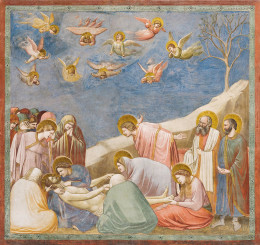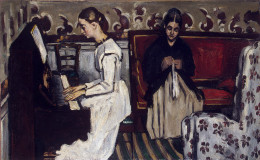Лано Крит
Aesthetic experience
Emotions:
Cruelty
Lamentations did not appear in art north of the Alps until the 14th century, but then became very popular there, and Northern versions further developed the centrality of Mary to the composition. The typical position of Christ's body changes from being flat on the ground or slab, usually seen in profile across the centre of the work, to the upper torso being raised by Mary or others, and finally being held in a near-vertical position, seen frontally, or across Mary's lap. Mary Magdalene typically holds Jesus' feet, and Joseph is usually a bearded older man, often richly dressed. In fully populated Lamentations the figures shown with the body include The Three Marys, John the Apostle, Joseph and Nicodemus, and often others of both sexes, not to mention angels and donor portraits.
Giotto di Bondone's famous depiction in the Scrovegni Chapel includes ten further female figures, who are not intended to be individualized as they have no halos. The subject became increasingly a separate devotional image, concentrating on Mary's grief for her son, with less narrative emphasis; the logical outcome of this trend was the Pietà, showing just these two figures, which was especially suitable for sculpture.
Aesthetic experience
The painting depicts Berthe Morisot's mother, Marie-Joséphine, and her favourite sister, Edma Pontillon. Since the beginning of their artistic career, the two sisters had learned their art together. However, in 1869 her sister got married and gave up painting at the insistence of her husband. In this painting, Edma was pregnant with her first child.
Unlike her friend Édouard Manet, who found it difficult to get his works accepted, Morisot was able to exhibit this painting at the Salon, along with The Harbor at Lorient, something that she was doing since 1864, and that would last until 1874, when she joined the first impressionist exhibition with her work, The Cradle.
This work received a positive review, despite being a "feminine painting". After her death, the work ceased to be exhibited. It was not until the middle of the 20th century that it began to interest the experts.
Two characters are depicted in the work, Edma Pontillon, Berthe's sister, and Mme. Morisot. As it was common in the painting of women artists, the subjects represented are domestic scenes or landscapes, as well as self-portraits or still life. In this case, we can see the artist's mother reading a book, an activity that gives the painting its original title, and her sister appears with a pensive expression. During this time, Edma was pregnant with her first child, and surely her thoughts were focused on the loss of having to put her married life before her devotion to painting. In one of the constant letters that she exchanged with Berthe, she wrote her: "I am often with you, dear Berthe, in spirit; I'm in your studio and I'd love to get away for just a quarter of an hour so I can breathe in the atmosphere we've lived in for years." She was trying to complement family life and art for a while, but, as she told her sister, it was impossible, as she was often too tired even to paint a small canvas. Berthe was also in a moment of crisis; despite her great personal consideration, the art world did not make it easy for women artists.

